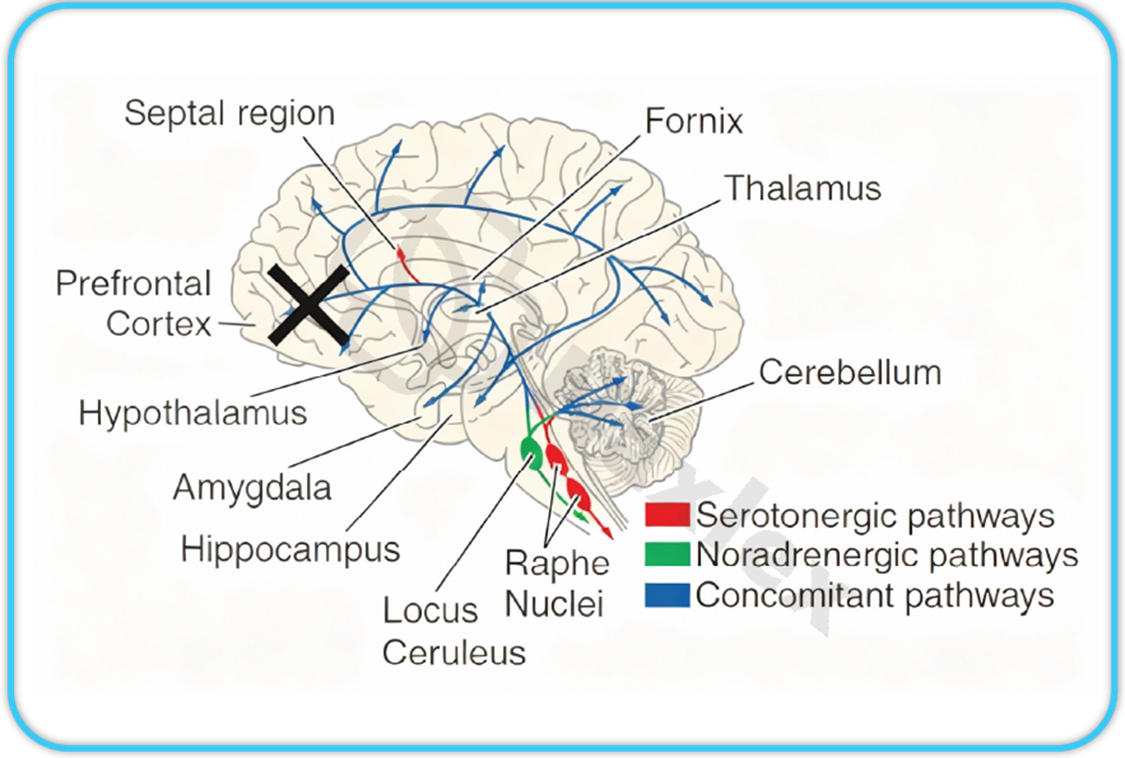Personality Disorders > Mental Health
Exam Review
Practice Exercise 3
Total Questions : 21
Showing 21 questions, Sign in for moreWhich behaviors should a nurse expect when working with a client with histrionic personality disorder? Select all that apply
A 45-year-old male client with no psychiatric history is admitted to the emergency department after physically assaulting his wife. The client is frightened by his loss of control. He tells the nurse that he is self-employed, recently expanded his company nationally, and has many well-known friends. His wife angrily states, “That’s what is important to you; who you know and how it looks!” Despite recent financial losses, the client continues his lavish lifestyle. The nurse determines that the client’s behavior is typical of:
Individuals with antisocial personality disorder often exhibit poor judgment, emotional distance, aggression, and impulsivity. A nurse understands that besides the limbic system, which other area of the brain is implicated in causing these behaviors? Place an X on the affected area.
Explanation

Antisocial personality disorder (ASPD) is a chronic mental condition characterized by disregard for others, violation of social norms, and impulsive aggression. It is associated with dysfunction of brain regions responsible for emotional regulation, judgment, and behavior inhibition. Neuroimaging shows reduced prefrontal activity, particularly in the orbitofrontal and ventromedial areas, leading to impaired moral reasoning and impulse control. Low serotonin and altered noradrenergic signaling also contribute to aggression and emotional detachment in affected individuals.
Rationale for correct answer
Prefrontal Cortex: The prefrontal cortex governs executive functioning, decision-making, and emotional regulation. In antisocial personality disorder, this region shows hypoactivity, impairing the ability to plan, empathize, and control impulses. The lack of inhibitory control allows unchecked limbic-driven emotions such as aggression or risk-taking to dominate behavior. Lesions or developmental deficits in this area result in socially inappropriate actions and moral insensitivity. The prefrontal cortex thus integrates higher reasoning and behavioral restraint, making its dysfunction central to ASPD traits.
Rationale for incorrect answers
Amygdala: The amygdala mediates fear and aggression, but alone it cannot explain poor moral reasoning or social decision-making. Dysfunction increases aggression but does not impair executive control.
Hippocampus: The hippocampus is essential for memory formation and spatial learning, not impulse regulation. Damage causes memory deficits but does not produce the disinhibited or antisocial behaviors of ASPD.
Hypothalamus: The hypothalamus regulates autonomic and endocrine responses, influencing hunger, sleep, and stress. Its dysfunction alters physiological states, not moral or judgmental capacities linked to social behavior.
Thalamus: The thalamus acts as a sensory relay center. While it contributes to attention and consciousness, it does not directly control emotional restraint or decision-making involved in antisocial traits.
Cerebellum: The cerebellum coordinates movement and balance. Though it plays minor roles in emotion, it primarily affects motor precision, not cognitive or moral processes related to ASPD.
Locus Ceruleus: The locus ceruleus releases norepinephrine for arousal and alertness. Dysfunction causes changes in vigilance or sleep but not the persistent behavioral disinhibition seen in ASPD.
Raphe Nuclei: The raphe nuclei produce serotonin affecting mood and arousal. While low serotonin links to impulsivity, it is a biochemical factor, not a structural cause of moral or social dysfunction.
Septal Region and Fornix: The septal region and fornix are limbic connections aiding emotion and memory integration. Dysfunction affects motivation and arousal but not higher-order decision-making or moral judgment.
Take Home Points
- The prefrontal cortex regulates judgment, inhibition, and moral reasoning, and its dysfunction leads to antisocial traits.
- The limbic system controls emotions, but prefrontal regulation prevents impulsive or aggressive actions.
- Serotonin imbalance contributes to impulsivity but structural prefrontal deficits are central to antisocial behavior.
- Differentiating ASPD from other conditions like borderline personality disorder requires assessing empathy, impulse control, and moral awareness.
A nurse is caring for a client diagnosed with borderline personality disorder who is self-mutilating. Which actions should be taken by the nurse to prevent further self-mutilation by the client? Prioritize the nurse’s actions by placing each step in the correct order.
Situation: Kim has a diagnosis of borderline personality disorder. She often exhibits alternating, clinging and distancing behaviors. The most appropriate nursing intervention with this type of behavior would be to:
Kim manipulates the staff in an effort to fulfill her own desires. All of the following may be examples of manipulative behaviors in the borderline client except:
“Splitting” by the client with borderline personality disorder denotes:
Situation: Jack was arrested for breaking into a jewelry store and stealing thousands of dollars’ worth of diamonds. At his arraignment, the judge ordered a psychological evaluation. He has just been admitted by court order to the locked unit. Based on a long history of maladaptive behavior, he has been given the diagnosis of antisocial personality disorder.
Which of the following characteristics would you expect to assess in Jack?
Milieu therapy is a good choice for clients with antisocial personality disorder because it:
In evaluating Jack’s progress, which of the following behaviors would be considered the most significant indication of positive change?
Which of the following behavioral patterns is characteristic of individuals with histrionic personality disorder?
A client arrived at the psychiatric unit from the emergency department. His diagnosis is personality disorder, and he exhibits manipulative behavior. As the nurse reviews the unit rules with him, the client asks, “Can I go to the snack shop just one time and then I will answer whatever you ask?” What is the nurse’s most appropriate response?
A nurse is discharging a client diagnosed with narcissistic personality disorder. Which employment opportunity is most likely to be recommended by the treatment team?
The nurse working with a client with antisocial personality disorder would expect which of the following behaviors? Select all that apply
Irresponsible, guiltless behavior is to a client diagnosed with cluster B personality disorder as avoidant, dependent behavior is to a client diagnosed with a:
A client diagnosed with a personality disorder tells the nurse, “When I was a waiter, I used to spit in the dinners of annoying customers.” This statement would be associated with which personality disorder?
A male client diagnosed with a personality disorder boasts to the nurse that he has to fight off female attention and is the highest paid in his company. These statements are reflective of which personality disorder?
A client diagnosed with borderline personality disorder is admitted to a psychiatric unit with recent self-inflicted cuts to both arms. Which of the following would explain this behavior? Select all that apply
When assessing a client diagnosed with passive-aggressive personality disorder, the nurse might identify which characteristic behavior?
A client diagnosed with antisocial personality disorder states, “My kids are so busy at home and school they don’t miss me or even know I’m gone.” Which nursing diagnosis applies to this client?
A nurse is working in the orientation phase of a therapeutic relationship with a client who has borderline personality disorder. What will be most difficult for the client at this stage of the relationship?
Sign Up or Login to view all the 21 Questions on this Exam
Join over 100,000+ nursing students using Naxlex’s science-backend flashcards, practice tests and expert solutions to improve their grades and reach their goals.
Sign Up Now


